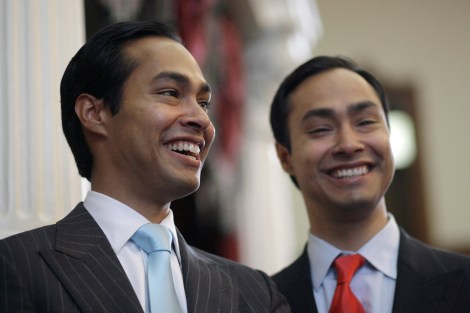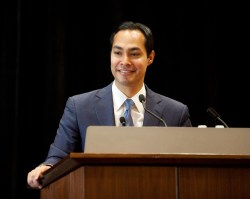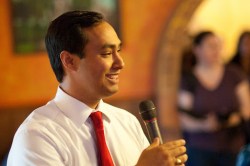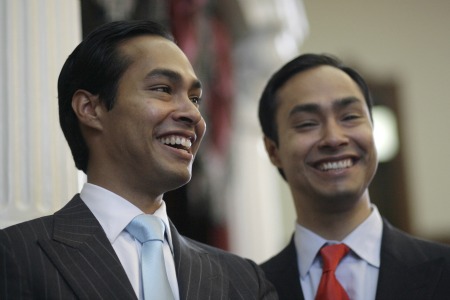
The other Castro brothers: Julián (left) and Joaquín. (Photo by Harry Cabluck/AP.)
Julián Castro is about to be catapulted into the national spotlight. On Sept. 4, the 37-year-old mayor of San Antonio, Texas, will give the keynote address at the Democratic National Convention — a primo speaking gig that catapulted another promising young politician into the national spotlight eight years ago.
Julián will likely be introduced on stage by his identical twin brother, Joaquín, who’s no slouch himself. Joaquín is expected to win a seat in Congress in November.
Both brothers went to Stanford and then to Harvard Law School. Both are frequently cited as rising political stars — though they look barely old enough to be student-body president. And both are outspoken advocates for clean energy in a deeply red state.
Lest you get the brothers Castro confused, I’ll introduce them one at a time …
Meet Julián

Julián: he’s the mayor. (Photo by The Texas Tribune.)
Since being elected mayor in 2009, Julián Castro has taken dramatic strides to turn San Antonio, the seventh-largest U.S. city, into a national leader in renewables and efficiency.
Just a few months after assuming office, he got invited to an economic forum at the White House to talk about his city’s successes. President Obama razzed the then-35-year-old for looking like an intern, then listened intently to what he had to say:
Castro told the president and assembled economic luminaries that San Antonio’s city-owned utility, CPS Energy, was making great use of federal stimulus funding to weatherize homes.
The mayor can brag about lots of other accomplishments at CPS during his tenure. He has led an impressive turnaround at a utility that used to be known “for its bullheaded reliance on a fleet of enormous nuclear and coal-fired power plants built decades ago,” as Forrest Wilder reports in the Texas Observer. Castro extricated CPS from an expensive and troubled nuclear-expansion deal. Last year, CPS announced that it will shut down a 900-megawatt coal-fired power plant by 2018.
Now, thanks in large part to Castro, the utility is following a “New Energy Economy” plan, and has renewable-friendly leadership that meets regularly with environmental groups. In 2010, the utility pledged to get 20 percent of its power from renewables by 2020, and it’s on track to far surpass that goal. The mayor and CPS officials have struck a number of deals to add solar capacity, bring cleantech companies to the city, and train workers for green jobs.
The mayor’s big idea has been to tie clean-power purchase agreements to economic investments in the city. Last year, when CPS put out a call for bids from solar companies, bidders had to explain not only how they would deliver solar power but what facilities they would build in San Antonio and how many jobs they would create.
Last month, that approach paid off big time. CPS signed a landmark deal with OCI Solar Power that will lead to the construction of five solar plants in the state providing 400 megawatts of power. It’s the largest solar project by a municipal utility in the U.S., CPS said, and will make Texas one of the top five solar-producing states. The deal will also have Nexolon America build a $100 million solar-component plant in San Antonio, creating an estimated 800 good-paying jobs. And both OCI Solar Power and Nexolon America are moving headquarters to San Antonio.
This doesn’t mean that Castro and CPS have given up on fossil fuels. The mayor has talked up the economic boost the region is getting from fracking for oil at the Eagle Ford shale deposit in South Texas. And CPS has signed a power-purchase agreement with a “clean coal” plant.
But Castro’s real passion appears to be for renewables: “San Antonio can be for the new energy economy what Silicon Valley is to software and what Boston is to biotech,” he said last year.
After a 350.org activist pointed out that Castro still wasn’t talking much about climate change, the mayor took up her challenge and declared September 2011 to be “Climate Change Awareness Month” in the city.
Beyond renewables, the mayor’s got some green ideas about transportation. He’s called for high-speed rail or commuter rail in central Texas. Under his watch, San Antonio has launched a bike-sharing system and small car-sharing program. The city has twice celebrated a ciclovía — or, as it calls it, a “Síclovía” — by closing two miles of a downtown road to cars on a Sunday so cyclists, roller-skaters, skateboarders, and pedestrians can take over.
Castro has also been an advocate for water conservation — a smart strategy in drought-plagued Texas. “The politics and availability of water will be an increasingly important issue in the 21st century,” he told Time in 2010 when asked what he thought was the most overlooked issue facing the country. San Antonio started getting serious about water conservation years before Castro took office, but he has pushed efforts forward; the city now has a water-recycling system and a water-storage facility, and it’s building a desalination plant.
San Antonians seem to approve. They reelected Julián Castro with 83 percent of the vote last year.
Meet Joaquín

Joaquín: He’s the likely congressman-to-be.
Joaquín Castro — the younger brother by one minute — has meanwhile been advocating for a clean energy economy in the state legislature, and he hopes to do the same next year in Congress. He’s running in the 20th congressional district, which includes much of San Antonio and is heavily Democratic and Latino; barring some freak occurrence, he’s expected to win handily.
Like his brother, Joaquín frequently talks up the importance of clean-energy industries. He’s won praise from the nonprofit Wind Coalition for supporting growth in the wind sector.
During more than nine years representing a San Antonio district in the Texas House, Joaquín has racked up great ratings from environmental groups. Last year, he got a 100-percent score [PDF] from the Texas League of Conservation Voters and near-perfect marks [PDF] from the state Sierra Club. The TLCV also endorsed him as a “champion of conservation” in 2008. Earlier this year, the nonprofit Environment Texas praised him for standing up for Clean Water Act protections.
Joaquín has been a “consistent, stellar member” of the Texas legislature, says Cyrus Reed, acting director of the Sierra Club’s Lone Star Chapter. “Both brothers have been consistently strong on environmental issues.”
Their future’s so bright …
Eighty-six percent of Latino voters would prefer that the government invest in clean energy rather than fossil fuels, according to a recent poll [PDF] sponsored by the Sierra Club and the National Council of La Raza. And 77 percent believe that climate change is already happening (compared to 52 percent of all Americans), while another 15 percent say it will happen in the future.
On these issues, the Castro brothers are clearly more in sync with American Latinos than are rising Hispanic stars on the other side of the aisle, like Ted Cruz, Susana Martinez, and Marco Rubio.
With Latinos expected to make up 25 percent of the U.S. populace by 2050, up from 15.5 percent in 2010, the population’s green-leaning views could be good news for Democrats and climate hawks alike. And long before 2050, Latinos could help elect a President Castro — or two.



